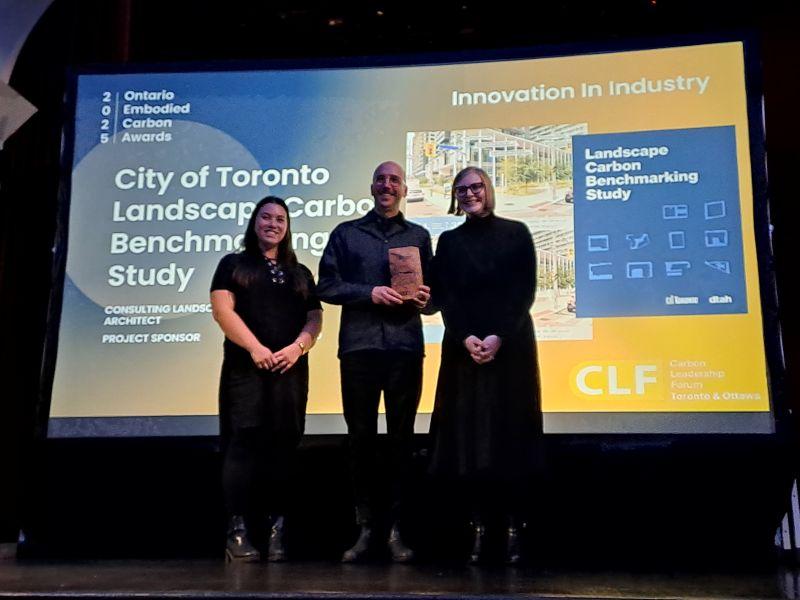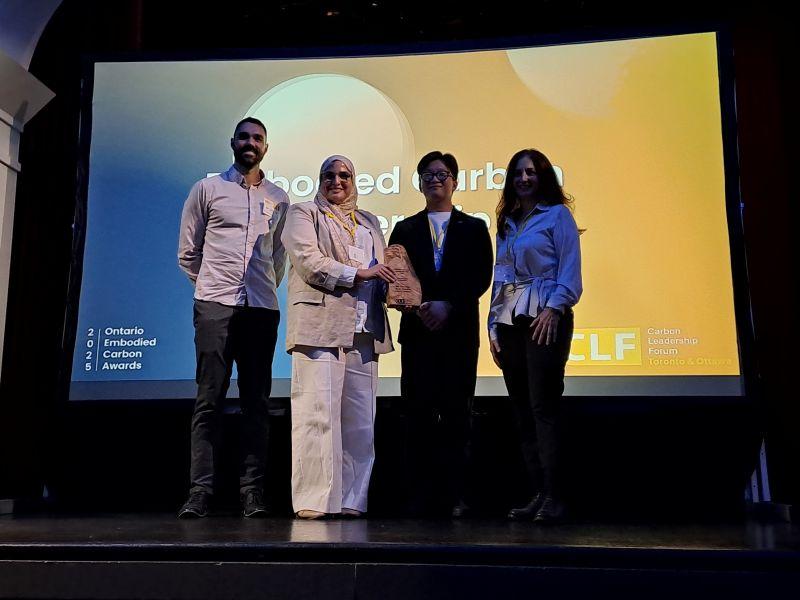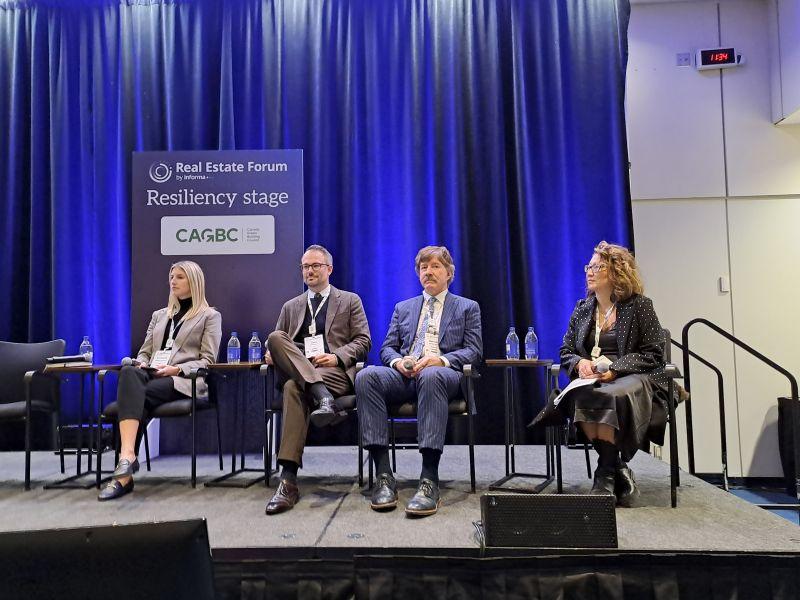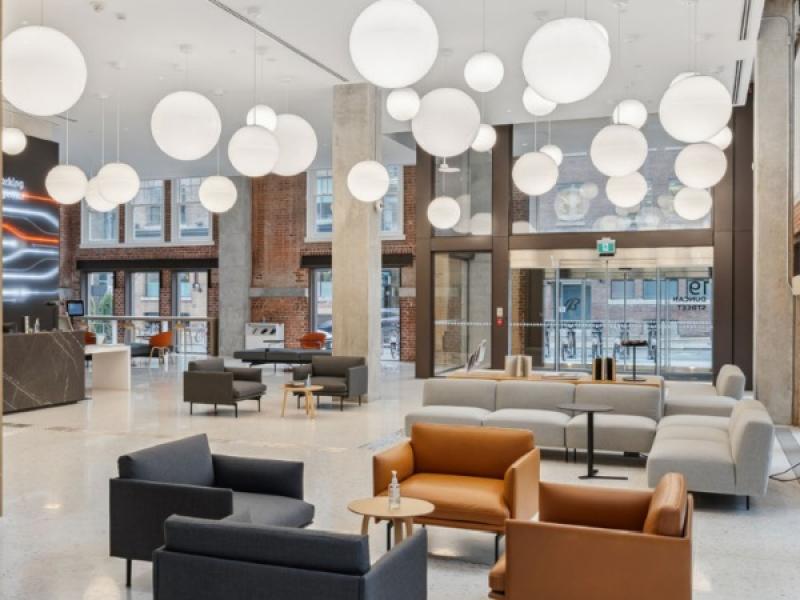
What do a 200,000-square-foot police facility, a farmhouse constructed of straw bale walls and a townhome community in Rexdale have in common? They have all been honoured by the 2025 Ontario Embodied Carbon Awards.
Held Thursday at The Great Hall in Toronto, the third awards ceremony of its kind, organized by the Toronto and Ottawa hubs of the Carbon Leadership Forum, acclaimed Ontario-based organizations and projects which are setting an example for reducing embodied carbon from buildings.
Embodied carbon, the greenhouse gas emissions that arise from the life cycle of building materials, is responsible for approximately 11 per cent of global greenhouse gas emissions, according to the American Institute of Architects.
A 2017 report by the United Nations found almost half of the carbon emissions from new construction around the world between 2020 and 2050 will come from embodied carbon.
“The most important example is to share the lessons that we’re learning – that we can do this together and we’re stronger when we do it together as an industry,” Colin Berman, an associate partner at Toronto-based design firm DTAH, said in an interview with Sustainable Biz Canada after winning the award for innovation.
Building awards
New Construction - Large Buildings
The Peel Police Operational Support Facility designed by DIALOG won the award for New Construction – Large Buildings.
Located in Mississauga, the 200,000-square-foot building is fully electric and features an onsite solar array. Its hybrid structural system is made of mass timber, and low-carbon concrete was used for the foundation and core.
The embodied carbon intensity is projected to be 276 kilograms of carbon dioxide equivalent per square metre (kgCO2e/m2).
“I feel very fortunate that we partnered with a team like DIALOG, who pushed design to the limits and put forward a very innovative building,” Adam Vaiya, an advisor with the Region of Peel’s Office of Climate Change and Energy Management, said in an interview.
The Region of Peel’s net-zero standard sets the bar "for how we should realize net-zero development,” Charles Marshall, a partner at DIALOG, said.
Peel Region has 10 facilities being built to its net-zero emissions standard, Vaiya said. The municipality will be aiming to push its standard further, providing more guidance on what it expects on embodied carbon from a building life-cycle assessment.
New Construction - Small Buildings
The Douro Farmhouse, built by Straworks and Building Alternatives in Douro-Dummer township, was the winner of the New Construction - Small Buildings category. It was built out of a mix of plant-based materials, earth and minimal use of concrete.
The farmhouse embodies approximately 28 kgCO2e/m2 across its 4,000 square feet of floor space.
The straw bale walls, for example store 9,588 kilograms of CO2, while being locally sourced, highly regenerative and non-toxic. Cellulose was used for the insulation, trapping 2,642 kilograms of CO2.
Retrofits & Reuse
The Retrofit & Reuse award was handed to ENFORM Architects and Stantec, recognizing their efforts at 50 Torbolton Dr. in Rexdale.
Managed by Toronto Community Housing, the site formerly held a two-storey residential building that stood vacant for over 12 years due to persistent basement flooding. It was redeveloped into a community of 17 three-bedroom townhomes.
A top-to-bottom replacement of interior finishes, major upgrades to the building envelope, and a complete replacement of the existing mechanical and electrical systems were undertaken for the retrofit.
ENFORM and Stantec tackled the embodied carbon of the building enclosure by analyzing how a continuous thermal blanket could be created with materials such as mineral wool, while being cost-effective, Kevin Stelzer, the founding principal of ENFORM, said in an interview.
“For us, every project is a showcase of what just good detailing, good architecture could really do in terms of lowering overall embodied carbon,” Kevin Pu, a principal at ENFORM, said.
“Ultimately we think zero-carbon is high value,” Stelzer added.
An upcoming ENFORM project designed around low embodied carbon is the Cove Zero mass timber building planned for Dartmouth, N.S.
Emerging Scopes, Innovation, Leadership
Emerging Scopes
The new award for emerging scopes, which recognizes projects reducing embodied carbon in building elements often overlooked in traditional whole-building life-cycle assessments, went to Daniels on Parliament in Toronto.
The condo in 25 Dreamers Way is said to represent Ontario’s largest deployment of low-carbon concrete for a multi-unit residential building. More than 22,000 cubic metres of the concrete was poured, or 73 per cent of the concrete to build the project. The concrete, made by Holcim, is named ECOPact.
Developer Daniels Corporation also conducted one of Ontario’s first publicly shared comprehensive design vs. as-built embodied carbon audits. The audit compared modelled volumes, strengths, additive and waste factors to the construction effort.
Innovation in Industry

The innovation award went to the Landscape Carbon Benchmarking Study, commissioned by the City of Toronto and prepared by DTAH. It was called the first Canadian study to establish benchmarks for embodied carbon in urban development landscapes.
DTHA analyzed 10 development sites in Toronto to calculate the embodied carbon and carbon sequestration potential. It found modest design decisions, such as reducing hardscape areas, can yield substantial reductions. For example, a theoretical redesign of one case study resulted in a 34 per cent reduction in embodied carbon and a 325 per cent increase in carbon sequestration.
Designers can learn from the study, while municipalities can build frameworks for policies such as a buildings standard, Berman said.
Embodied Carbon Leadership
The award for leadership was given to BDP Quadrangle Studio, a Toronto-based architectural firm, in recognition of its efforts to embed carbon awareness into every level of its practice.
Its notable efforts include:
- validating a 46.2 per cent carbon emissions reduction target with the Science Based Targets initiative by 2030 and exceeding it in 2024; and
- completing over 100 project life-cycle assessments, representing over three million square metres of floor area.
“We have to do this, we have to do it fast,” Michelle Xuereb, the innovation director and co-director of BDP, said about reducing embodied carbon. “I love that within the industry there’s been a real openness to collaborate, to share what we’ve learned, to talk to each other, and rationalize it together.”










